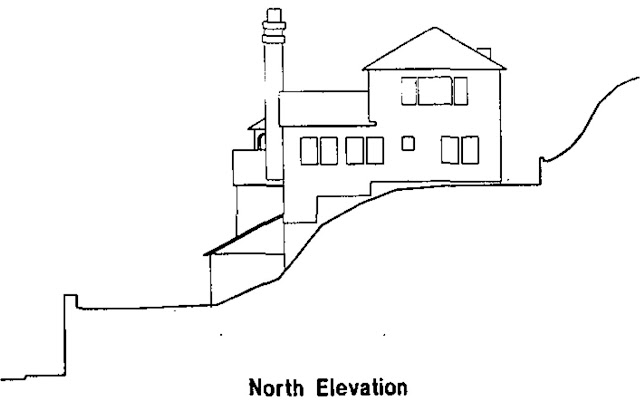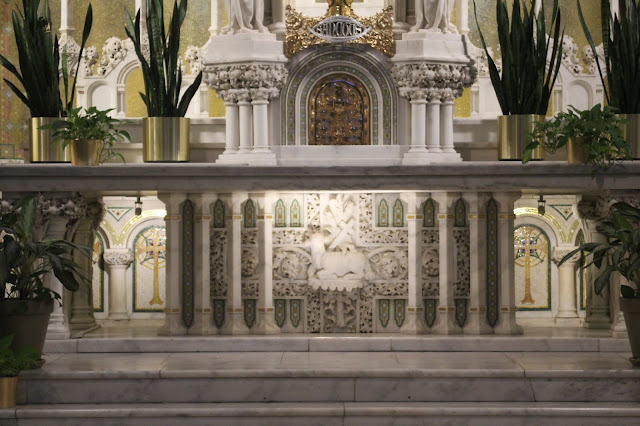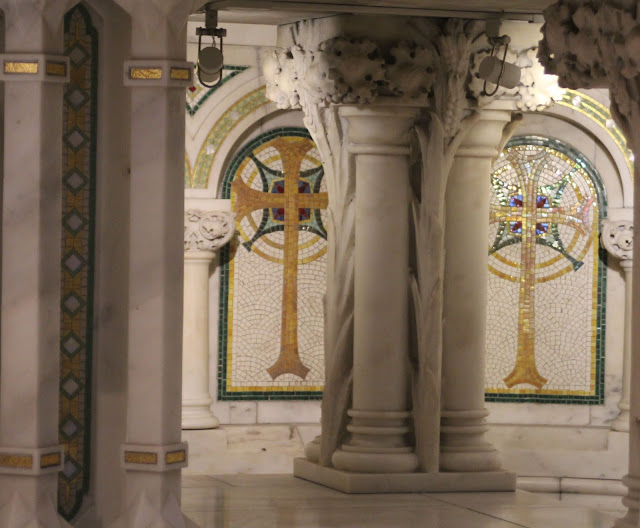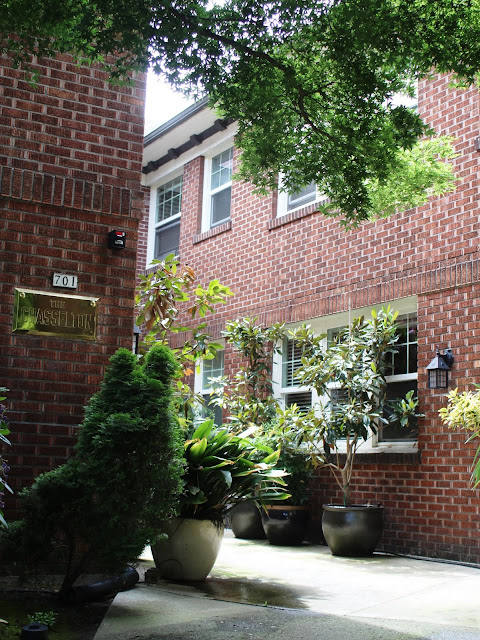Another of the earlier designs of my architect first-cousin-twice-removed,
Ewald Theodore Pape (1894-1976), is this house at 257 SW Marconi Avenue in Portland, Oregon. This house is adjacent to
Washington Park.
I've written about this house before, but it was nice to see it in person on my trip to Oregon in June 2018. The photo below was taken on the 11th of that month.
Note what's happening on the upper left side of the house, just above and to the right of the front door. Here's a close-up:

It turns out this house has had at least two, and possibly three, additions (that I could find a record of) since Ewald originally designed it in 1926. Here is a photograph of the house from approximately May 1981, when the City of Portland did its Historic Resource Inventory (it can be found from
this link in the
Oregon Historic Sites Database):

The Historic Resource Inventory notes a "two-story addition at rear," but also notes that this happened in 1926, which can't be correct unless it was part of the original plans. The first mention I found of the house, called the George A. and Jessie Garden [sic] Donald House in the Oregon Historic Sites Database, was a record of the building permit (house value: $20,000) in the September 4, 1926
Oregonian. The owner is
George Alexander Donald (1886-1944) and his wife is
Jessie Gordon Munro Donald (1882-1968), both originally from Scotland. His first initial is missing from the November 4, 1926
plumbing permit, pictured below:

The March 29, 1932
Oregonian indicates "Nine-Room House Sold - Spanish Mediterranean Home on Marconi Bought" by
Otto Klein (1868-1951) and his wife
Cora Riggs Klein (1883-1976), operators of the Knickerbocker Restaurant, which was located in the (New) Imperial Hotel at Broadway and Stark (now the
Hotel Lucia) from 1920 to 1940. Prior to that, Klein operated some other well-known early Portland restaurants, such as the
Hof Brau (where, before Prohibition, crawfish were cooked in wine) and the "L" Cafeteria.
The Kleins did some remodeling (adding another bathroom for sure) but did not live in the house very long - they are at another address on the 1940 Census. By the June 28, 1935
Oregonian, a Mr. and Mrs. Pearce C. Davis are living in the house.
An article in the May 8, 1938
Oregonian notes the "Klein Home Leased...to Kwan Yoshida, Japanese consul, who has just recently been assigned to Portland." He was replaced that autumn by Motoki Matsumura, who died in an auto accident near Butte, Montana, according to the July 22, 1939
Oregonian. His replacement, Shiroji Yuki, was in the house with his wife Tsuroko and five-year-old son Hirotake, according to an article in the October 17, 1939
Oregonian. A November 8, 1940
Oregonian article noted that Yuki was recalled to Japan, and was not replaced until well after World War II and the Kleins' ownership of the house.
John Richard Becker and his wife Madge were living in the house at the time of John's death on September 15, 1951 (September 19, 1951
Oregonian death notice). The house was on the market November 28, 1954 (ad in the
Oregonian), with an asking price of $35,000.
Long-time (and controversial) lawyer and state senator (1939-1951 and 1961-1974)
Thomas R. Mahoney (1896-1978) owned the house by September 25, 1956 (fuel tank permit). He lived at this address through at least March 23, 1970 (
Oregonian article). A little over a year later, the house was on the market again (March 31, 1971
Oregonian ad), with an asking price of $47,500. By August 25, 1974 (
Oregonian ad), the house was on the market again, this time with an asking price of $87,000. The last recorded sale was in November 2000, for $639,050.
The house is described in the Oregon Historic Sites Database as Mediterranean Revival style. Special features and materials noted on the Portland Historic Resource Inventory are:
Clay tile hip, gable, and pent roofs. Stuccoed walls. Round-arched entrance doorway. Segmental-arched picture window. Engaged polygonal tower with round-arched windows. Wrought-iron balconet, lanterns, and grille.
These features are visible in the various June 2018 photographs in this post.
Here is the east elevation (view looking west from Marconi Avenue) drawing of the house that shows how the house looked prior to a 2002 remodeling - most likely, this is how it looked as Ewald designed it:

Here is the east elevation with the 2002 addition included, which added 520 square feet to the master suite on the uppermost level - the addition has been crosshatched:
Here's another view of the changes, this time of the north elevation (looking south at the house from a point north of it). The first is pre-2002:

And this second is after the 2002 expansion of the master suite (the shaded area):
Here is a rough floor plan for the fifth level, with the part shaded yellow being the master suite prior to 2002, and the area outlined in red being the 520 square feet added to it:
Below, you can see the bay window area of the remodeled master suite, in the upper right corner of the photo. Below it are the kitchen and breakfast nook (the latter in the "engaged polygonal tower" referred to in the Historic Resource Inventory), and to the left, the dining room with the "wrought-iron balconet."
This photo shows the rest of the 2002 master suite addition. It looks like the windows in this area might open to a small private balcony. One of the two wrought-iron grilles is clearly visible too. It's above the kitchen (the arched windows on the left) and a bedroom (on the right).
I was glad to find the plans for the 2002 and 2017-18 additions and renovations on the
PortlandMaps.com website, as I wondered, when I took the photo of the garage below, how one got from it up into the house. (Note the patio just above it, and the wrought-iron grillwork in the round window for the staircase to the front door.)
Turns out there is an enclosed stairwell at the back of the garage....
...which leads up to a second level that includes more enclosed stairs up, a mechanical closet, and access to the patio above the garage.
The enclosed stairwell continues up to the third level, which has a full bath (I believe this is the one added by the Kleins, in 1935), a family room (part of which is the lower half of the "engaged polygonal tower"), and storage closets.
Finally, these stairs open up onto the fourth level, which is the main floor of the house. The drawing below (click on it to make it larger) I believe represents the house as Ewald originally designed it. Note the vaulted ceiling of the living room and the large library. Also note that the orientation has changed from the previous three levels shown - on this next one, the front (Marconi) side of the house is at the top, rather than at the right.

The latest addition, started in 2017 and still underway in June 2018, is adding two more bedrooms, another bathroom, and a study on the uppermost (5th) level. It is also adding an extension to the back (west) side of the house, in part to create a landing partway up the stairs for access to these new rooms. The area below will mostly just partly cover the back patio, but a "mud room" is also being created on the main level under part of the fifth level overhang. It will add 914 square feet, bringing the total in the living spaces to 4154 (the garage is 576 square feet).
So what do I think of all these changes? From the ones done in 2002, they appear to maintain the consistency of the house's appearance, and, from the plans, it looks like the 2017-18 addition will do the same. I would MUCH rather see this house added to in this way, than completely torn down!
Finally, here is what the public entrance to the house looks like from street level. The house number is on the left, and the nickname of the house is on the right. The nickname is ironic as Ewald designed a small apartment complex in early 1927 that was apparently called the "Villa Marconi," at least originally.

Here's another photo, showing the wrought-iron lanterns referred to earlier, that I inadvertently cut off in my photo above.
© Amanda Pape - 2018 -
click here to e-mail me.

















































